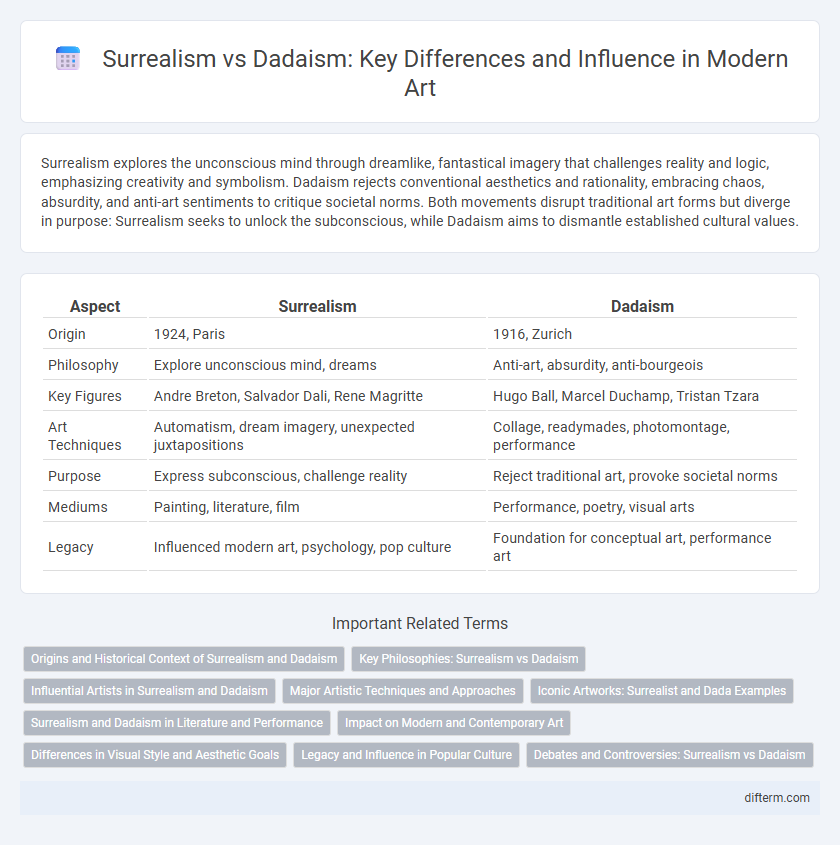Surrealism explores the unconscious mind through dreamlike, fantastical imagery that challenges reality and logic, emphasizing creativity and symbolism. Dadaism rejects conventional aesthetics and rationality, embracing chaos, absurdity, and anti-art sentiments to critique societal norms. Both movements disrupt traditional art forms but diverge in purpose: Surrealism seeks to unlock the subconscious, while Dadaism aims to dismantle established cultural values.
Table of Comparison
| Aspect | Surrealism | Dadaism |
|---|---|---|
| Origin | 1924, Paris | 1916, Zurich |
| Philosophy | Explore unconscious mind, dreams | Anti-art, absurdity, anti-bourgeois |
| Key Figures | Andre Breton, Salvador Dali, Rene Magritte | Hugo Ball, Marcel Duchamp, Tristan Tzara |
| Art Techniques | Automatism, dream imagery, unexpected juxtapositions | Collage, readymades, photomontage, performance |
| Purpose | Express subconscious, challenge reality | Reject traditional art, provoke societal norms |
| Mediums | Painting, literature, film | Performance, poetry, visual arts |
| Legacy | Influenced modern art, psychology, pop culture | Foundation for conceptual art, performance art |
Origins and Historical Context of Surrealism and Dadaism
Surrealism emerged in the early 1920s as a reaction to the horrors of World War I, rooted in the psychoanalytic theories of Freud and emphasizing the unconscious mind and dream imagery. Dadaism originated slightly earlier, around 1916 in Zurich, as an anti-war, anti-art movement rejecting traditional aesthetics and rationality in response to the devastation of World War I. Both movements reflect profound disillusionment with contemporary society but diverge in Surrealism's focus on the subconscious versus Dadaism's embrace of chaos and absurdity.
Key Philosophies: Surrealism vs Dadaism
Surrealism centers on unlocking the unconscious mind to explore dreams, imagination, and irrational juxtapositions, seeking deeper realities beyond logical reasoning. Dadaism rejects conventional art and societal norms through absurdity, anti-art, and chaos, challenging established cultural values and promoting spontaneity. Both movements emphasize breaking free from tradition, but Surrealism pursues transformative inner visions while Dadaism embodies anarchic critique and nihilism.
Influential Artists in Surrealism and Dadaism
Salvador Dali and Rene Magritte stand as monumental figures in Surrealism, known for their dream-like imagery and exploration of the subconscious mind. In the realm of Dadaism, Marcel Duchamp and Hannah Hoch revolutionized art by challenging traditional aesthetics through ready-mades and photomontages. Both movements influenced modern art deeply by questioning reality and embracing absurdity.
Major Artistic Techniques and Approaches
Surrealism employs automatic drawing, dream imagery, and unexpected juxtapositions to explore the unconscious mind and unlock hidden creativity. Dadaism utilizes collage, photomontage, and ready-made objects to challenge traditional art norms and promote anti-art sentiments through absurdity and randomness. Both movements emphasize breaking conventions but diverge in intent; Surrealism seeks psychological depth while Dadaism focuses on political and social critique.
Iconic Artworks: Surrealist and Dada Examples
Salvador Dali's "The Persistence of Memory" epitomizes Surrealism with its dreamlike melting clocks that challenge perceptions of time and reality. Marcel Duchamp's "Fountain," a readymade urinal signed "R. Mutt," exemplifies Dadaism's anti-art stance and critique of traditional artistic values. Both artworks revolutionized 20th-century art by pushing boundaries of creativity, symbolism, and societal norms.
Surrealism and Dadaism in Literature and Performance
Surrealism in literature and performance emphasizes dreamlike, illogical narratives that explore the unconscious mind, often employing automatic writing and symbolic imagery to challenge reality. Dadaism, emerging as a radical anti-art movement, uses absurdity, nonsense, and fragmented structures in poems, manifestos, and theatrical performances to reject traditional artistic conventions. Both movements profoundly influenced 20th-century avant-garde culture, with Surrealism focusing on psychological depth and Dadaism on anarchic disruption.
Impact on Modern and Contemporary Art
Surrealism revolutionized modern and contemporary art by exploring subconscious imagery, dreamscapes, and irrational juxtapositions, heavily influencing movements like Abstract Expressionism and Pop Art. Dadaism, with its anti-art stance, political activism, and use of found objects, challenged traditional aesthetics and paved the way for performance art, conceptual art, and punk culture. Both movements redefined artistic boundaries, emphasizing experimentation and the critique of societal norms that resonate throughout 20th and 21st-century art practices.
Differences in Visual Style and Aesthetic Goals
Surrealism emphasizes dream-like imagery, unusual juxtapositions, and subconscious exploration to evoke emotional and psychological depth, often utilizing detailed and realistic techniques. Dadaism, by contrast, embraces chaos, absurdity, and anti-art aesthetics with collage, photomontage, and random assemblages that reject traditional artistic standards. While Surrealism seeks to unlock the unconscious mind and explore symbolic meaning, Dadaism primarily aims to challenge societal norms and provoke intellectual disruption.
Legacy and Influence in Popular Culture
Surrealism profoundly shaped popular culture by inspiring visual arts, literature, and cinema with its dreamlike imagery and exploration of the unconscious mind, influencing films like "Un Chien Andalou" and artists such as Salvador Dali. Dadaism's legacy lies in its radical challenge to traditional aesthetics and authority, laying the groundwork for contemporary performance art, conceptual art, and punk culture through its use of absurdity and anti-art techniques. Both movements disrupted cultural norms and continue to inspire avant-garde artists and designers in fashion, advertising, and digital media.
Debates and Controversies: Surrealism vs Dadaism
Surrealism and Dadaism sparked intense debates over the role of rationality and absurdity in art, with Surrealism embracing the unconscious mind and dream imagery, while Dadaism championed anti-art and chaos as a form of political protest. Critics argued that Surrealism's exploration of deep symbolism sometimes betrayed Dada's foundational rejection of traditional aesthetic values and societal norms. These controversies highlighted the divergent philosophies: Surrealism's pursuit of psychological depth contrasted sharply with Dadaism's nihilistic approach to meaning and artistic convention.
Surrealism vs Dadaism Infographic

 difterm.com
difterm.com